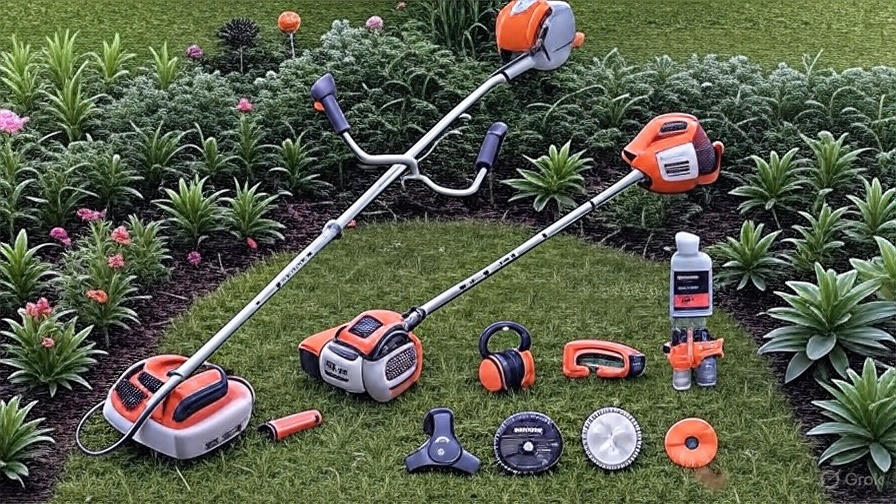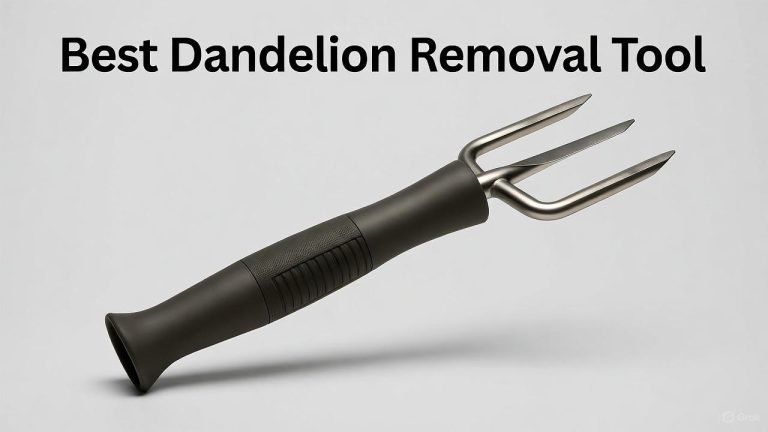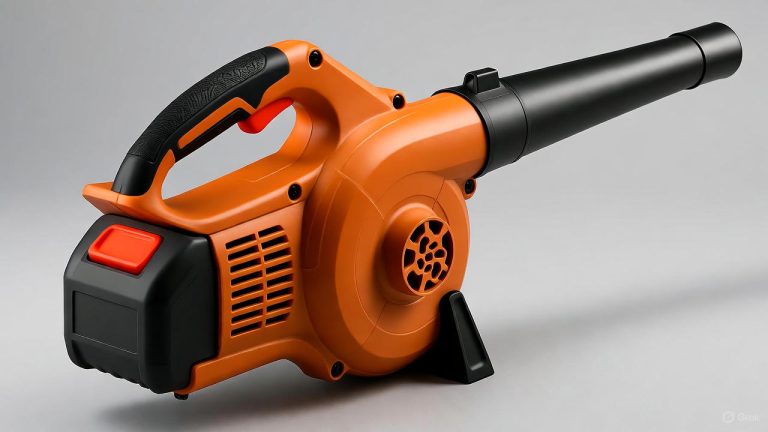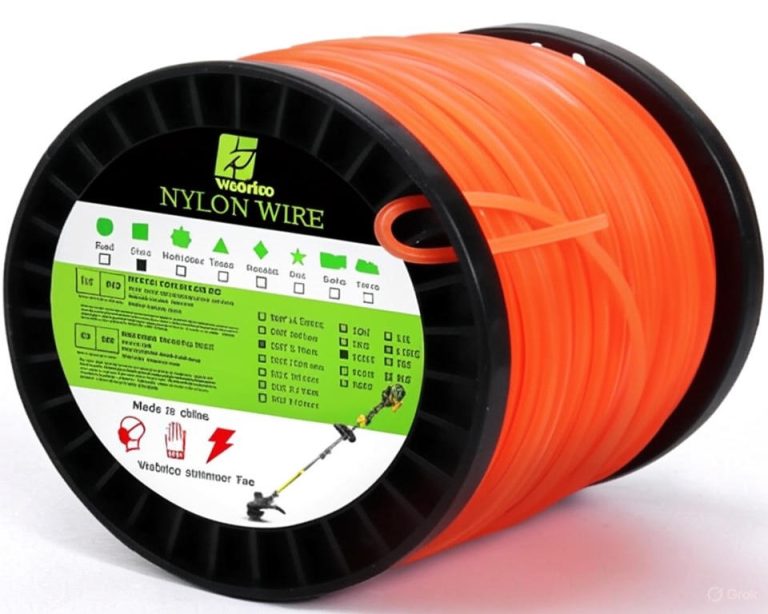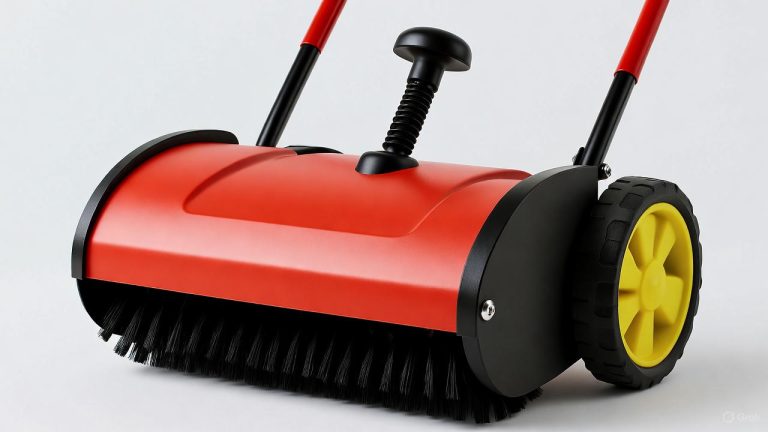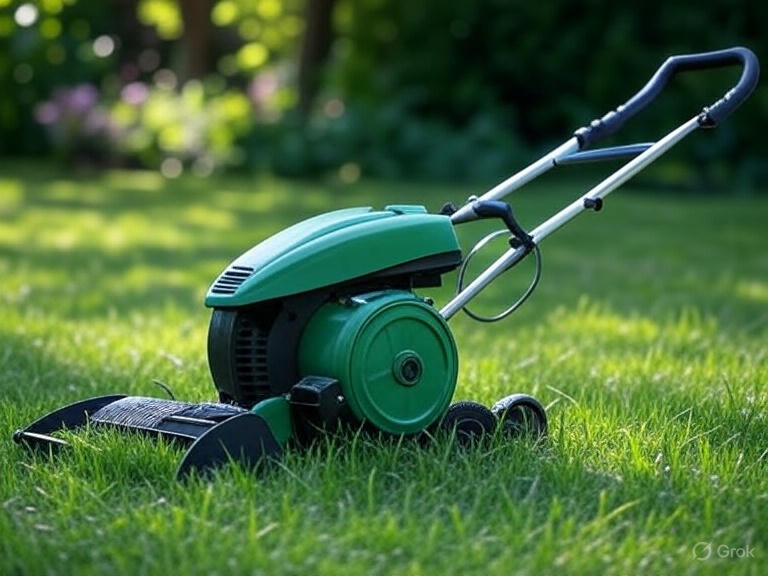5 Best 4-Cycle String Trimmers In 2025
Lawn maintenance requires reliable tools that deliver consistent performance while minimizing environmental impact. Four-cycle string trimmers have emerged as the preferred choice for homeowners and professionals who demand superior power without the hassle of fuel mixing. These advanced machines offer cleaner emissions, better fuel economy, and reduced maintenance compared to traditional two-cycle alternatives.
The evolution of outdoor power equipment has brought significant improvements in engine technology. Four-cycle engines burn gasoline and oil separately, which results in more complete combustion and lower emissions. This design also extends engine life and reduces the frequency of maintenance tasks.
Professional landscapers and dedicated homeowners recognize the value of investing in quality equipment that performs consistently season after season. The right string trimmer transforms tedious yard work into efficient lawn care, making quick work of overgrown edges, thick weeds, and hard-to-reach areas that mowers cannot handle.
This comprehensive review examines five top-rated four-cycle string trimmers that represent the best options available today. Each model offers unique features and capabilities designed to meet different needs and budgets. From lightweight residential units to heavy-duty professional machines, these trimmers showcase the latest advances in four-cycle engine technology.
Understanding 4-Cycle Engine Technology
Four-cycle engines operate through four distinct phases: intake, compression, power, and exhaust. During the intake stroke, the piston moves down while the intake valve opens, drawing the air-fuel mixture into the cylinder. The compression stroke follows as the piston moves up, compressing the mixture for optimal combustion.
The power stroke occurs when the spark plug ignites the compressed mixture, forcing the piston down and transferring power to the crankshaft. Finally, the exhaust stroke pushes burned gases out through the exhaust valve as the piston moves up again. This complete cycle repeats continuously during operation.
The separation of oil and fuel in four-cycle engines provides numerous advantages. Oil lubricates internal components without burning, which reduces emissions and extends engine life. Users simply add regular gasoline to the fuel tank and check oil levels periodically, eliminating the guesswork and mess associated with fuel mixing.
Four-cycle engines typically produce more torque at lower RPMs compared to two-cycle alternatives. This characteristic translates to better cutting performance in thick vegetation and reduces the strain on both the engine and operator. The steady power delivery also creates less vibration, which improves comfort during extended use.
Maintenance requirements for four-cycle engines focus on regular oil changes and air filter cleaning rather than frequent spark plug replacement. Many models feature easy-access panels and tool-free components that simplify routine maintenance tasks. Some advanced units include oil monitoring systems that alert users when service is due.
Key Features to Consider
Engine displacement directly affects power output and cutting capability. Larger engines typically handle tougher jobs but add weight to the overall unit. The sweet spot for most residential applications falls between 25cc and 35cc, while professional users often prefer 40cc or larger engines for maximum performance.
Shaft design impacts both balance and versatility. Straight shafts provide better reach and allow the use of blade attachments, making them ideal for heavy-duty applications. Curved shafts offer improved balance and reduce fatigue during lighter trimming tasks, though they limit attachment compatibility.
Starting systems vary significantly among models. Traditional recoil starters require physical effort but offer simplicity and reliability. Electric start systems eliminate pull-cord fatigue but add weight and complexity. Some manufacturers offer primer bulbs and easy-start mechanisms that reduce the effort required for manual starting.
Handle configuration affects operator comfort and control. D-handles provide excellent control for precision work and are standard on most straight-shaft models. Loop handles distribute weight more evenly and reduce fatigue during extended use. Some models feature adjustable handles that accommodate different operator heights and preferences.
Cutting head design determines the type of cutting line and feeding mechanism. Bump-feed heads advance line when tapped against the ground, providing convenient operation without stopping the engine. Fixed-line heads require manual line replacement but offer consistent cutting performance. Some advanced heads feature automatic line advancement based on engine speed.
1. Troy-Bilt 41BD304S766: Reliable Performance for Home Use
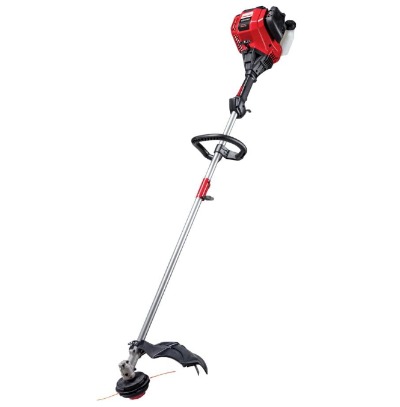
The Troy-Bilt 41BD304S766 delivers dependable performance with its 17cc four-cycle engine that eliminates fuel mixing requirements. This straight-shaft trimmer targets homeowners who need reliable equipment for regular lawn maintenance without professional-grade complexity.
The 17-inch cutting width handles most residential trimming tasks efficiently while the straight shaft design provides excellent reach around obstacles and under low-hanging branches. The attachment capability expands functionality by accepting compatible accessories like edgers, hedge trimmers, and cultivators.
Starting this trimmer proves straightforward thanks to the primer bulb and reliable recoil system. The engine fires up consistently even after extended storage periods, which many users appreciate. Once running, the engine delivers smooth power throughout the RPM range without the surging common in lesser units.
The dual-line bump-feed head advances 0.095-inch line automatically when tapped against the ground. This system works reliably and accepts standard replacement line available at most hardware stores. The cutting head removes easily for line replacement without requiring tools.
Ergonomic design features include a padded shoulder strap that distributes weight evenly across the torso. The D-handle provides secure grip and precise control during detailed trimming work. Vibration levels remain manageable even during extended use sessions.
Build quality meets expectations for the price point. The shaft assembly feels solid and the engine housing shows good attention to detail. Some components appear lightweight but hold up well under normal residential use. The air filter access requires minimal effort for routine cleaning.
Fuel efficiency impresses users who previously operated two-cycle trimmers. The separate oil reservoir maintains proper lubrication while the fuel tank accepts regular unleaded gasoline. Operating costs remain low due to the efficient combustion process and reduced maintenance requirements.
The attachment capability sets this model apart from basic trimmers. Compatible accessories transform the unit into a versatile yard care system. However, users should verify attachment compatibility before purchase since not all Troy-Bilt accessories work with every model.
Performance in thick grass and light brush satisfies most homeowners. The engine provides adequate torque for typical suburban landscapes but may struggle with extremely dense vegetation. The 17cc displacement strikes a good balance between power and weight for residential applications.
Customer feedback highlights the reliability and ease of use as primary strengths. Many users report trouble-free operation across multiple seasons with minimal maintenance. The four-cycle engine eliminates the frustration of fuel mixing and provides more consistent starting compared to older two-cycle units.
2. PROYAMA 40cc: Heavy-Duty Power for Demanding Tasks

The PROYAMA 40cc gas-powered brush cutter brings serious power to challenging landscaping tasks. This robust four-cycle machine targets users who encounter thick brush, dense weeds, and overgrown areas that overwhelm lighter trimmers.
The 40cc engine displacement provides substantial torque for cutting through tough vegetation. This power advantage becomes apparent when tackling thick grass, small saplings, and woody stems that stop smaller engines. The four-cycle design delivers smooth power without the aggressive surging associated with overpowered two-cycle units.
Three-in-one functionality includes string trimming, brush cutting, and grass cutting capabilities. The package includes both a dual-line cutting head and a three-tooth metal blade for maximum versatility. Users can switch between cutting attachments based on the specific task requirements.
The straight shaft design with front D-handle provides excellent control and leverage for heavy-duty work. This configuration allows operators to apply downward pressure when needed while maintaining precise control over the cutting head. The shaft length accommodates most operator heights without causing back strain.
Starting procedures remain straightforward despite the larger engine size. The primer bulb and choke system prepare the engine for reliable starts even in cold conditions. Once warmed up, the engine restarts easily throughout the work session.
The bump-feed string head accepts heavy-duty 0.105-inch line that resists breaking in tough conditions. The robust construction handles the stresses of demanding applications better than lighter duty heads. Line advancement works smoothly with a firm tap against the ground.
Build quality reflects the heavy-duty nature of this machine. The engine housing uses substantial materials that resist damage from debris and impacts. The shaft assembly feels solid and shows no flex even when cutting thick material. All connection points appear robust and well-engineered.
Weight distribution benefits from thoughtful design despite the larger engine. The included shoulder harness transfers load away from the arms and reduces fatigue during extended cutting sessions. Proper adjustment of the harness and handle position creates a balanced feel that minimizes operator strain.
Vibration isolation systems help manage the increased power output. Engine mounts and handle dampening reduce the transmission of vibrations to the operator. While not as smooth as smaller engines, the vibration levels remain acceptable for the power class.
Fuel consumption reflects the larger displacement but remains reasonable for the work capacity. The separate oil system maintains proper lubrication while the large fuel tank provides extended runtime between fills. Operating costs stay competitive due to the elimination of pre-mixed fuel requirements.
The metal blade capability sets this unit apart from string-only trimmers. The three-tooth blade handles woody stems and thick brush that would wrap around string lines. Safety equipment becomes critical when using blade attachments due to the increased cutting force and potential for debris.
Performance in extreme conditions showcases the power advantage. Dense brush, thick weeds, and overgrown areas that challenge other trimmers submit to the 40cc engine. The torque reserve prevents stalling even when cutting material near the maximum capacity.
Professional users appreciate the durability and power output for demanding applications. The robust construction handles daily use in tough conditions while the four-cycle engine provides reliable starting and consistent performance. Maintenance requirements remain manageable despite the heavy-duty nature.
3.SENIX GTBCU4QL-M: Balanced Performance and Value
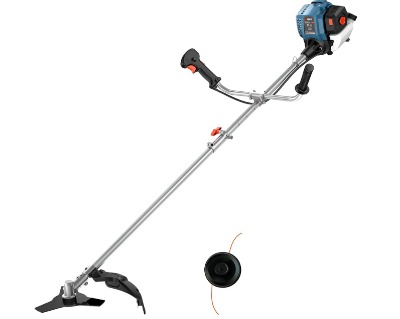
The SENIX GTBCU4QL-M 4QL combines 31cc of four-cycle power with thoughtful design features that appeal to both homeowners and light commercial users. This straight-shaft trimmer targets the middle ground between basic residential units and heavy-duty professional machines.
The 31cc displacement provides ample power for most trimming and edging tasks while maintaining reasonable weight and fuel consumption. The engine delivers consistent torque throughout the RPM range, making it effective against thick grass and light brush without overwhelming novice users.
The 17.7-inch cutting width covers substantial ground with each pass, reducing the time required for large trimming jobs. The generous cutting diameter works particularly well for open areas and long fence lines where efficiency matters more than precision.
Starting characteristics benefit from the four-cycle design and proper engineering. The primer bulb system prepares the fuel mixture while the recoil starter provides reliable ignition. Cold starts require brief warm-up periods but hot restarts happen immediately throughout the work session.
The front D-handle configuration provides excellent control and leverage for various cutting angles. The handle position allows operators to guide the cutting head precisely while maintaining comfortable arm positions. The straight shaft extends reach and accepts compatible blade attachments.
Bump-feed line advancement works smoothly with the included dual-line head. The system accepts standard 0.095-inch line and advances appropriate amounts with firm ground contact. The head removes easily for line replacement and cleaning maintenance.
Build quality meets expectations for the price category. The engine housing uses adequate materials while the shaft assembly provides good rigidity. Some components show cost-conscious design but maintain functionality and durability under normal use conditions.
The edger capability adds value for property maintenance tasks. The trimmer converts to an edger configuration for creating clean borders along sidewalks and driveways. This dual functionality eliminates the need for separate equipment in many applications.
Weight distribution works well with the included shoulder strap. The 31cc engine adds some heft compared to smaller units but remains manageable for most operators. Proper strap adjustment and handle position create balanced operation that reduces fatigue.
Vibration management shows good attention to operator comfort. Engine isolation and handle dampening keep vibration levels reasonable during extended use. The smooth four-cycle power delivery contributes to the comfortable operation characteristics.
Fuel efficiency benefits from the four-cycle design and proper engine tuning. The separate oil and fuel systems optimize both lubrication and combustion for maximum efficiency. Operating costs remain low due to the use of regular gasoline and extended maintenance intervals.
Air filter access simplifies routine maintenance tasks. The cover removes without tools for quick cleaning and inspection. The foam filter element cleans easily with soap and water, extending service life and maintaining proper airflow.
Performance across various conditions shows the versatility of the 31cc power plant. Light residential tasks happen easily while moderate commercial applications remain within capability. The torque output handles thick grass and weeds without frequent stalling.
Customer satisfaction reflects the balance of features and value. Users appreciate the reliable starting, smooth operation, and versatile capabilities. The four-cycle engine eliminates mixing concerns while providing more consistent performance than comparable two-cycle units.
Attachment compatibility expands the utility beyond basic trimming. Compatible accessories include edger attachments, cultivators, and other lawn care tools. The straight shaft design accepts most universal attachments with proper adapters.
4.Wild Badger Power 2-in-1: Professional Versatility
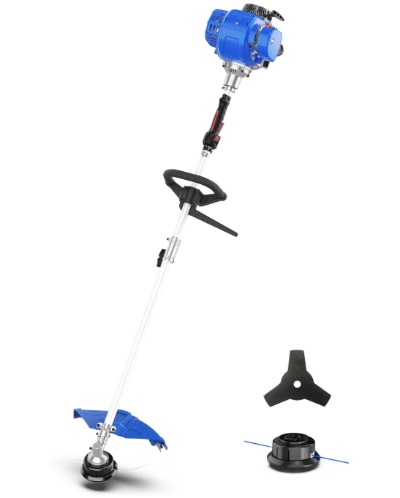
The Wild Badger Power 2-in-1 system elevates yard care efficiency with its 31cc four-cycle engine and comprehensive accessory package. This straight-shaft multi-tool targets users who need professional-grade versatility without investing in multiple separate machines.
The 31cc displacement strikes an optimal balance between power output and operational weight. The engine provides sufficient torque for challenging cutting tasks while maintaining fuel efficiency and manageable weight distribution. Four-cycle technology ensures clean operation without fuel mixing requirements.
The multi-tool design accepts various attachments that transform the basic trimmer into specialized equipment. The included brush cutter and string trimmer attachments handle different vegetation types effectively. The system concept reduces storage requirements and maintenance costs compared to separate machines.
Starting procedures reflect professional-grade engineering with reliable ignition systems. The primer bulb and choke combination prepares the engine for consistent starts in various weather conditions. Once warmed up, the engine restarts immediately throughout the work session.
The straight shaft with front handle provides excellent leverage and control for demanding applications. This configuration allows operators to apply appropriate pressure while maintaining precise cutting head guidance. The shaft length accommodates different operator sizes without compromising reach or balance.
The included shoulder harness distributes weight effectively across the torso and reduces arm fatigue during extended cutting sessions. Professional users appreciate the robust harness construction that withstands daily use in demanding conditions. Proper adjustment creates balanced operation that minimizes operator strain.
Build quality reflects the professional target market with robust construction throughout. The engine housing uses substantial materials that resist damage from debris and impacts. All connection points show solid engineering designed to handle the stresses of commercial applications.
The brush cutter attachment handles woody stems and thick vegetation that overwhelms string trimmer heads. The metal blade cuts cleanly through material up to small sapling size, making it effective for property cleanup and maintenance tasks. Safety considerations become paramount when operating blade attachments.
String trimmer functionality covers routine maintenance tasks with dual-line cutting heads. The bump-feed system advances line reliably with ground contact while the robust construction handles the demands of professional use. Standard line sizes ensure easy replacement availability.
Vibration isolation systems manage the power output effectively to maintain operator comfort. Engine mounts and handle dampening reduce vibration transmission while maintaining solid feel and control. The isolation systems work particularly well during sustained cutting operations.
Fuel efficiency benefits from optimized four-cycle engine tuning and proper carburetor calibration. The separate oil and fuel systems maximize both lubrication and combustion efficiency. Extended runtime between fuel stops increases productivity in commercial applications.
Air filter design emphasizes easy maintenance with tool-free access panels. The large filter element handles dusty conditions effectively while remaining easy to clean and replace. Regular filter maintenance ensures consistent engine performance and extends service life.
Performance characteristics suit both residential and light commercial applications. The power output handles thick grass, weeds, and light brush effectively while the multi-tool capability reduces equipment investment and storage requirements. The system works particularly well for property maintenance services.
Attachment versatility extends beyond the included accessories with compatibility for other lawn care tools. The universal shaft design accepts cultivators, edgers, and other implements that expand the system capabilities. Users should verify compatibility before purchasing additional attachments.
Customer feedback emphasizes the professional build quality and versatile performance. Users appreciate the reliable starting, smooth operation, and comprehensive accessory package. The four-cycle engine provides consistent performance while eliminating the complexity of fuel mixing.
5.NEO-TEC 31cc: Feature-Rich Value Package
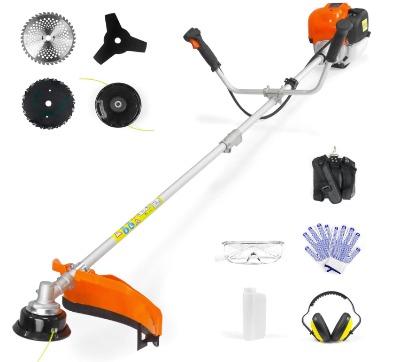
The NEO-TEC 31cc 4-in-1 system delivers comprehensive cutting capability with its feature-rich design and extensive accessory package. This versatile machine targets users who want maximum functionality from a single power unit without compromising performance or reliability.
The 31cc four-cycle engine provides robust power output for diverse cutting applications while maintaining reasonable fuel consumption and weight characteristics. The engine design emphasizes smooth power delivery and reliable starting across various operating conditions.
Four-in-one functionality includes string trimming, edging, brush cutting, and grass cutting capabilities through interchangeable attachments. The comprehensive package eliminates the need for multiple machines while providing specialized tools for different vegetation types and cutting requirements.
The 17-inch cutting width with dual-line capability handles routine trimming tasks efficiently. The bump-feed advancement system works reliably with standard replacement line while the robust head construction withstands demanding applications. Line replacement procedures remain straightforward without requiring special tools.
The 10-inch brush cutter attachment tackles woody stems and thick vegetation that challenges string trimmer heads. The three-blade design cuts cleanly through material up to moderate thickness while the robust construction handles the stresses of heavy-duty cutting. Proper safety equipment becomes essential when operating blade attachments.
Rubber U-handle design provides secure grip and precise control during various cutting operations. The ergonomic shape reduces hand fatigue while the rubber material provides positive grip even with gloves. Handle position adjusts to accommodate different operator preferences and cutting angles.
The included shoulder strap distributes weight effectively and reduces operator fatigue during extended cutting sessions. The padded design and adjustable length create comfortable operation for different body sizes. Proper strap adjustment balances the unit and minimizes strain on arms and back.
Starting characteristics benefit from thoughtful engineering with primer bulb and reliable recoil systems. The engine fires consistently even after extended storage periods while hot restarts happen immediately throughout the work session. The four-cycle design eliminates starting difficulties associated with stale fuel mixtures.
Build quality shows attention to both functionality and value with appropriate materials throughout. The engine housing provides adequate protection while the shaft assembly maintains proper rigidity. Connection points appear robust and well-engineered for the intended applications.
Light weight design philosophy emphasizes operator comfort without sacrificing essential strength. The power-to-weight ratio compares favorably with competing units while the balanced design reduces fatigue during sustained operation. The lightweight construction particularly benefits users who require extended runtime.
Stability features include vibration dampening systems that manage engine power effectively. The isolation mounts and handle design reduce vibration transmission while maintaining solid control characteristics. The smooth four-cycle power delivery contributes to the stable operation.
Fuel system design incorporates separate oil and gasoline reservoirs that simplify operation and maintenance. Users add regular unleaded gasoline without mixing requirements while the oil system maintains proper lubrication automatically. Operating costs remain competitive due to efficient combustion and extended maintenance intervals.
Air filter access emphasizes easy maintenance with removable covers and washable elements. The filter design handles normal dust and debris effectively while remaining simple to clean and service. Regular maintenance ensures consistent engine performance and maximizes service life.
Performance across diverse applications showcases the versatility of the 31cc power plant. Light commercial tasks and demanding residential applications remain within capability while the multi-tool design reduces equipment investment. The system excels at property maintenance and landscaping tasks.
Attachment security systems ensure safe operation with proper connection mechanisms for each implement. The quick-change design allows rapid switching between attachments while maintaining secure mounting. Users should verify proper attachment before operation to ensure safety and performance.
Customer satisfaction reflects the comprehensive feature package and reliable performance. Users appreciate the extensive accessory selection, smooth operation, and value proposition. The four-cycle engine provides consistent starting and operation while the multi-tool capability maximizes utility and minimizes storage requirements.
Maintenance and Care Guidelines
Proper maintenance extends equipment life and ensures reliable performance across multiple seasons. Four-cycle engines require different care procedures compared to two-cycle alternatives, but the maintenance tasks remain straightforward for most users.
Oil changes represent the most critical maintenance task for four-cycle engines. Fresh oil maintains proper lubrication and removes combustion byproducts that can cause engine damage. Most manufacturers recommend oil changes after the first five hours of operation and every 50 hours thereafter.
Air filter maintenance directly affects engine performance and longevity. Dirty filters restrict airflow and cause rich fuel mixtures that reduce power and increase emissions. Foam filters clean easily with soap and water while paper elements require replacement when dirty.
Spark plug inspection and replacement ensure reliable ignition and optimal engine performance. Four-cycle engines typically require spark plug service less frequently than two-cycle units due to cleaner combustion. Most plugs last an entire season with normal use.
Fuel system care prevents starting problems and performance issues. Users should add fuel stabilizer when storing equipment for extended periods and drain fuel systems before long-term storage. Fresh gasoline prevents carburetor clogging and starting difficulties.
Cutting head maintenance keeps string advancement systems working properly. Regular cleaning removes grass buildup and debris that can interfere with line feeding. Replacement line should match manufacturer specifications for proper cutting performance.
Storage procedures protect equipment during off-season periods. Clean equipment removes debris that can cause corrosion while proper storage locations prevent moisture damage. Battery-powered accessories require special attention to prevent damage from temperature extremes.
Safety Considerations
Operating string trimmers requires attention to safety procedures that protect both operators and bystanders. Proper safety equipment and operational awareness prevent most accidents and injuries associated with power equipment use.
Personal protective equipment includes safety glasses, hearing protection, long pants, and closed-toe shoes as minimum requirements. Face shields provide additional protection when operating in dusty conditions or around flying debris. Gloves improve grip but should not interfere with control operation.
Clear cutting areas of debris, stones, and other objects that could become projectiles when struck by the cutting head. The high-speed rotation can launch objects at dangerous velocities that cause property damage or personal injury. Maintain awareness of bystander locations during operation.
Blade attachments require additional safety precautions due to increased cutting force and debris potential. Operators should use extra caution around people, property, and obstacles when using metal blades. The cutting force can cause serious injury if contact occurs with the operator or others.
Fuel handling procedures emphasize fire prevention and proper ventilation. Store gasoline in approved containers away from heat sources and ignition points. Refuel equipment outdoors with the engine stopped and cool to prevent vapor ignition.
Performance Comparison Analysis
Engine displacement affects power output and cutting capability across all models tested. The 40cc PROYAMA provides maximum power for heavy-duty applications while the 17cc Troy-Bilt offers adequate performance for light residential use. The 31cc units strike a balance between power and weight for versatile applications.
Starting reliability varies among manufacturers but all four-cycle engines provide better cold starting than comparable two-cycle units. The elimination of fuel mixing reduces starting problems associated with incorrect ratios or stale pre-mix. Primer bulb systems further improve starting consistency.
Fuel efficiency benefits all four-cycle models compared to two-cycle alternatives. The separate oil and fuel systems optimize combustion while reducing emissions. Operating costs decrease due to the use of regular gasoline and extended maintenance intervals.
Weight distribution affects operator comfort and fatigue levels during extended use. Straight-shaft models provide better balance and reach while curved-shaft units offer improved maneuverability in tight spaces. Shoulder harnesses distribute weight effectively on all models tested.
Vibration levels remain manageable across all units despite the increased power output. Four-cycle engines produce smoother power delivery while isolation systems reduce transmission to the operator. Vibration differences between models reflect engineering priorities and cost considerations.
Attachment compatibility varies significantly among manufacturers. Universal systems accept a wide range of accessories while proprietary designs limit options to manufacturer-specific attachments. Users should consider future accessory needs when evaluating compatibility.
Build quality reflects intended use and price positioning. Professional-grade units use more robust materials and construction methods while residential models balance cost and durability. All models tested show adequate construction for their intended applications.
Cost-Benefit Analysis
Initial purchase prices vary significantly based on features, power output, and included accessories. The comprehensive packages offer better value for users who need multiple capabilities while basic models suit single-purpose applications. Professional users often justify higher costs through increased productivity and durability.
Operating costs favor four-cycle engines through improved fuel efficiency and reduced maintenance requirements. The elimination of pre-mixed fuel reduces convenience store markup while extended oil change intervals minimize service costs. Professional users realize additional savings through reduced downtime.
Depreciation rates depend on brand reputation, build quality, and market demand. Professional-grade equipment typically holds value better while residential units depreciate more rapidly. Proper maintenance extends useful life and maintains resale value for all equipment categories.
Productivity gains from reliable equipment justify higher initial costs for many users. Professional landscapers benefit from reduced service calls and consistent performance while homeowners appreciate reliable starting and smooth operation. Time savings often offset equipment cost differences.
Environmental Impact Considerations
Four-cycle engines produce significantly lower emissions compared to two-cycle alternatives due to more complete combustion and separate oil systems. The cleaner burning characteristics reduce air pollution while improved fuel efficiency decreases carbon footprint.
Noise pollution decreases with four-cycle technology due to smoother power delivery and better muffling systems. The reduced noise levels improve neighbor relations and comply with local noise ordinances that increasingly restrict landscape equipment operation.
Fuel consumption improvements reduce petroleum usage while extended equipment life decreases manufacturing demand. The longer service intervals also reduce waste oil generation and disposal requirements. Professional users can emphasize environmental benefits when marketing services.
Future Technology Trends
Battery technology continues improving with higher energy density and faster charging capabilities. Electric alternatives may eventually match gas engine performance while eliminating emissions and fuel mixing concerns. Current battery technology suits light residential applications but lacks power for demanding commercial use.
Engine technology advances focus on further emission reductions and improved fuel efficiency. Direct injection systems and advanced ignition timing optimize combustion while maintaining power output. These improvements benefit both environmental concerns and operating costs.
Smart features including hour meters, maintenance reminders, and diagnostic systems help users optimize equipment performance and service intervals. These technologies reduce maintenance guesswork while extending equipment life through proper care.
Conclusion and Recommendations
The best four-cycle string trimmer depends on specific user needs, application requirements, and budget considerations. Each model tested offers distinct advantages that appeal to different user categories and operational demands.
The Troy-Bilt 41BD304S766 serves homeowners who need reliable performance for routine maintenance tasks. The 17cc engine provides adequate power while the attachment capability adds versatility. The reasonable price and proven reliability make it an excellent choice for suburban properties.
The PROYAMA 40cc targets users who encounter challenging cutting conditions regularly. The substantial power output handles thick brush and dense vegetation that overwhelms smaller engines. Professional landscapers and property maintenance services benefit from the heavy-duty construction and blade capability.
The SENIX GTBCU4QL-M offers balanced performance for users who need more power than basic residential units but do not require maximum capability. The 31cc engine handles most applications effectively while the edger capability adds value. The price point appeals to cost-conscious buyers who want reliable performance.
The Wild Badger Power 2-in-1 system suits users who need professional-grade versatility and build quality. The comprehensive accessory package and robust construction justify the investment for demanding applications. The system concept reduces equipment inventory while providing specialized capabilities.
The NEO-TEC 31cc provides maximum features and accessories for users who want comprehensive functionality from a single power unit. The extensive package eliminates the need for multiple machines while the competitive pricing offers excellent value. The lightweight design appeals to users who prioritize comfort during extended operation.
All five models represent significant improvements over older two-cycle technology through cleaner operation, better fuel efficiency, and reduced maintenance requirements. The four-cycle engine technology has matured to provide reliable performance while meeting increasingly strict emission standards.
Professional users should prioritize build quality, power output, and attachment compatibility when evaluating options. The additional investment in robust construction pays dividends through reduced downtime and extended service life. Commercial applications justify premium features and capabilities.
Residential users can choose based on property size, vegetation type, and frequency of use. Light applications favor efficiency and ease of use while demanding conditions require additional power and durability. The attachment capability adds value for users with diverse yard care needs.
Regular maintenance extends equipment life and ensures reliable performance regardless of the model chosen. Proper oil changes, air filter service, and fuel system care prevent most problems while maintaining optimal operation. Users should follow manufacturer recommendations for service intervals and procedures.
Safety remains paramount regardless of equipment choice. Proper protective equipment, operational awareness, and maintenance procedures prevent accidents and injuries. The increased power of four-cycle engines requires respect and attention to safety protocols.
The investment in quality four-cycle string trimmer equipment pays dividends through improved performance, reduced environmental impact, and lower operating costs. These machines represent the current state of the art in handheld power equipment and provide excellent value for both professional and residential applications.

